Wednesday, August 09, 2006
BAHA
Bone Anchored Hearing Aidsdid not know about them till i got here. siguro nakatulog na naman ako during lectures! =p. so what are they really?
What is a Baha? 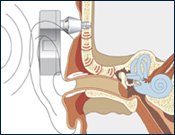 The Baha is a surgically implantable system for treatment of hearing loss that works through direct bone conduction. It has been used since 1977, and was cleared by the FDA in 1996 as a treatment for conductive and mixed hearing losses in the United States. In 2002, the FDA approved its use for the treatment of unilateral sensorineural hearing loss.
The Baha is a surgically implantable system for treatment of hearing loss that works through direct bone conduction. It has been used since 1977, and was cleared by the FDA in 1996 as a treatment for conductive and mixed hearing losses in the United States. In 2002, the FDA approved its use for the treatment of unilateral sensorineural hearing loss.
 The Baha is a surgically implantable system for treatment of hearing loss that works through direct bone conduction. It has been used since 1977, and was cleared by the FDA in 1996 as a treatment for conductive and mixed hearing losses in the United States. In 2002, the FDA approved its use for the treatment of unilateral sensorineural hearing loss.
The Baha is a surgically implantable system for treatment of hearing loss that works through direct bone conduction. It has been used since 1977, and was cleared by the FDA in 1996 as a treatment for conductive and mixed hearing losses in the United States. In 2002, the FDA approved its use for the treatment of unilateral sensorineural hearing loss. Baha is used to help people with chronic ear infections, congenital external auditory canal atresia and single sided deafness who cannot benefit from conventional hearing aids. The system is surgically implanted and allows sound to be conducted through the bone rather than via the middle ear - a process known as direct bone conduction.
How does a Baha work?
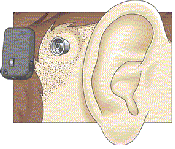 The Baha consists of three parts: a titanium implant, an external abutment, and a sound processor. The system works by enhancing natural bone transmission as a pathway for sound to travel to the inner ear, bypassing the external auditory canal and middle ear. The titanium implant is placed during a short surgical procedure and over time naturally integrates with the skull bone. For hearing, the sound processor transmits sound vibrations through the external abutment to the titanium implant. The vibrating implant sets up vibrations within the skull and inner ear that finally stimulate the nerve fibers of the inner ear, allowing hearing.
The Baha consists of three parts: a titanium implant, an external abutment, and a sound processor. The system works by enhancing natural bone transmission as a pathway for sound to travel to the inner ear, bypassing the external auditory canal and middle ear. The titanium implant is placed during a short surgical procedure and over time naturally integrates with the skull bone. For hearing, the sound processor transmits sound vibrations through the external abutment to the titanium implant. The vibrating implant sets up vibrations within the skull and inner ear that finally stimulate the nerve fibers of the inner ear, allowing hearing.
 The Baha consists of three parts: a titanium implant, an external abutment, and a sound processor. The system works by enhancing natural bone transmission as a pathway for sound to travel to the inner ear, bypassing the external auditory canal and middle ear. The titanium implant is placed during a short surgical procedure and over time naturally integrates with the skull bone. For hearing, the sound processor transmits sound vibrations through the external abutment to the titanium implant. The vibrating implant sets up vibrations within the skull and inner ear that finally stimulate the nerve fibers of the inner ear, allowing hearing.
The Baha consists of three parts: a titanium implant, an external abutment, and a sound processor. The system works by enhancing natural bone transmission as a pathway for sound to travel to the inner ear, bypassing the external auditory canal and middle ear. The titanium implant is placed during a short surgical procedure and over time naturally integrates with the skull bone. For hearing, the sound processor transmits sound vibrations through the external abutment to the titanium implant. The vibrating implant sets up vibrations within the skull and inner ear that finally stimulate the nerve fibers of the inner ear, allowing hearing.Who is a Candidate for the Baha System?
The Baha is used to rehabilitate people with conductive and mixed loss hearing impairment. This includes people with chronic infection of the ear canal, people with absence of or a very narrow ear canal as a result of a congenital ear malformation, infection, or surgery, and people with a single sided hearing loss as a result of surgery for a vestibular schwannoma (a tumor of the balance and hearing nerves).
The Baha is used to rehabilitate people with conductive and mixed loss hearing impairment. This includes people with chronic infection of the ear canal, people with absence of or a very narrow ear canal as a result of a congenital ear malformation, infection, or surgery, and people with a single sided hearing loss as a result of surgery for a vestibular schwannoma (a tumor of the balance and hearing nerves).
Chronic Ear Infection
Treatment for hearing losses with the Baha is suitable for people with a conductive or mixed hearing impairment caused by a chronic infection of the middle or outer ear that results in a persistent and unpleasant discharge. The first goal, of course, is to manage the infection. In rare cases, chronic infections fail to respond to treatment, but are determined to be non-threatening. In other cases, infections respond to treatment, but recur with use of a conventional in-the-canal hearing aid. When a hearing aid is placed in a susceptible ear canal, a chronic or recurrent infection may be aggravated by the obstruction of the canal and the resulting excessive humidity and lack of drainage. In these cases, the Baha may be a good solution for hearing rehabilitation.
The Baha sound processor transmits sound directly to the hearing nerve without involving the ear canal. With Baha there is no occlusion of the ear canal to aggravate infection. A Baha sound processor offers sound quality at least as good as a conventional air conduction device. For those who need high levels of amplification, problems related to feedback and discomfort are usually resolved.
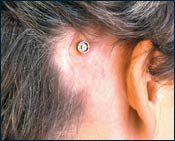
Treatment for hearing losses with the Baha is suitable for people with a conductive or mixed hearing impairment caused by a chronic infection of the middle or outer ear that results in a persistent and unpleasant discharge. The first goal, of course, is to manage the infection. In rare cases, chronic infections fail to respond to treatment, but are determined to be non-threatening. In other cases, infections respond to treatment, but recur with use of a conventional in-the-canal hearing aid. When a hearing aid is placed in a susceptible ear canal, a chronic or recurrent infection may be aggravated by the obstruction of the canal and the resulting excessive humidity and lack of drainage. In these cases, the Baha may be a good solution for hearing rehabilitation.
The Baha sound processor transmits sound directly to the hearing nerve without involving the ear canal. With Baha there is no occlusion of the ear canal to aggravate infection. A Baha sound processor offers sound quality at least as good as a conventional air conduction device. For those who need high levels of amplification, problems related to feedback and discomfort are usually resolved.

Congenital Hearing Loss
Congenital conductive hearing loss caused by a malformation of the middle or external ear resulting in a missing or incomplete ear canal (external auditory canal atresia) are effectively managed with a Baha. Traditionally people with this type of hearing loss have been offered an old-fashioned bone conducting hearing aid. These are either held on the head using a steel spring headband or included in the frame of a pair of glasses. Traditional bone conductors have several disadvantages. The sound quality is poor as the skin acts as a barrier for the sound to travel to the inner ear. They are uncomfortable - patients complain of pain and headaches due to the constant pressure of the headband. They are also cumbersome, obtrusive and insecure.
Congenital conductive hearing loss caused by a malformation of the middle or external ear resulting in a missing or incomplete ear canal (external auditory canal atresia) are effectively managed with a Baha. Traditionally people with this type of hearing loss have been offered an old-fashioned bone conducting hearing aid. These are either held on the head using a steel spring headband or included in the frame of a pair of glasses. Traditional bone conductors have several disadvantages. The sound quality is poor as the skin acts as a barrier for the sound to travel to the inner ear. They are uncomfortable - patients complain of pain and headaches due to the constant pressure of the headband. They are also cumbersome, obtrusive and insecure.
The Baha system can be a real solution for people with this type of impairment. The Baha sound processor is directly integrated to the skull bone. Because of this direct interface, the Baha offers significantly better sound quality than that of a traditional bone conductor. The Baha sound processor works without pressure on the skin avoiding the headaches and soreness associated with the conventional bone conductor. Baha offers excellent wearing comfort and a better aesthetic result.
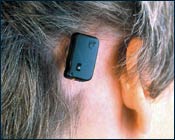 Baha for Unilateral Deafness
Baha for Unilateral DeafnessOne ear does not provide adequate hearing in many situations. Patients with severe hearing loss on one side, but normal hearing in the other ear have difficulty understanding speech in background noise (such as group conversations and restaurants) and determining which direction sound comes from. Unilateral deafness can result from viral infections, trauma, acoustic neuromas and other ear tumors and ear surgery.
Until recently, the best available approach for providing help in this situation has been the CROS (contralateral routing of offside signal) hearing aid. This technique utilized hearing aid microphones worn in both ears and routed sound from the deaf ear to the hearing ear. Unfortunately, most patients were unsatisfied with this system. Common complaints include the cosmetic appearance and discomfort of the headband, and the use of a hearing aid mold in the good ear. Most patients felt the benefit from the device is not worth the disadvantages.
The Baha, now an FDA cleared solution for unilateral deafness, provides a completely unique benefit. The Baha device is placed on the side of the deaf ear, transfers sound through bone conduction, and stimulates the cochlea of the normal hearing ear. The Baha effectively transmits sounds from the bad side to the normal ear and ultimately results in a sensation of hearing from a deaf ear. Stereo hearing results in improved understanding of speech, especially in background noise and aids in the localization of sound.
The Baha offers significant advantages to the traditional CROS hearing aid. The device is placed behind the ear leaving the canal open. It is worn under the hair and is not perceptible to others. Because it is held in place by a clip and directly integrated with the skull bone, there is no need for a head band and pressure against the skin of the head. In recent clinical trials patients prefer the sound and speech clarity achieved with the Baha verses the CROS and verses the unaided condition.
taken from UMMC website
The Baha offers significant advantages to the traditional CROS hearing aid. The device is placed behind the ear leaving the canal open. It is worn under the hair and is not perceptible to others. Because it is held in place by a clip and directly integrated with the skull bone, there is no need for a head band and pressure against the skin of the head. In recent clinical trials patients prefer the sound and speech clarity achieved with the Baha verses the CROS and verses the unaided condition.
taken from UMMC website
Posted by QT at 8/09/2006 10:56:00 am
Thursday, August 03, 2006
Cros/Bicros Aids
these aids are usually used if the patient has unilateral or asymmetric hearing loss. we don't fit much of these pero lately, it's getting more frequent. hmmn..what could have caused their unilateral/asymmetric losses - acoustic neuroma? middle ear problems? noise induced (like shooting on one side, gunfire)? trauma? vascular? the list goes on...
usually, hearing goes down at the same time on both ears. but if that is not the case, at least there's still another option. it might not be the best solution but at least, these may help.... it's not easy fitting these, u know? well, it's easy fitting them, technically. but getting the patients to wear a cord round the back of their head, getting them used to the idea that they have a microphone on one ear that will transmit sound to the other is a bit too much to take in. lalo na kung vain sila!
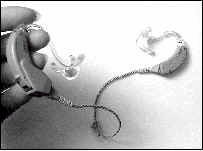

what you need: hearing aid, shoe, satellite microphone (looks like an aid) and cord.
anyways, these should explain more:
CROS/BiCROS hearing aids as defined by RNID.
(CROS - contralateral routing of signal)
These are for people with hearing in one ear only. CROS hearing aids pick up sound from the side with no hearing and feed it to the ear with normal or near normal hearing. BiCROS aids are similar but made for people with no useful hearing in one ear and some hearing loss in the other, so they make the sounds louder as well.
CROS/BiCROS as defined by NDCS
People with a profound unilateral deafness may benefit from a special type of hearing aid known as a CROS aid. Although it is described as a hearing aid, a CROS aid does not amplify sound. It simply transfers sound from the ear with deafness to the ear with hearing. The main advantage of using a CROS aid is that it can help the person to hear sounds from all directions.A CROS aid includes two units which both look like ordinary behind the ear hearing aids. However, the unit worn on the ear with deafness just contains a microphone. It is connected to the other unit, sometimes using a lead and sometimes using a wireless radio link. The patient listens to the sounds picked up by the microphone through the second unit, which they wear on their ear with hearing.BiCROS aids are used when there is no useful hearing in one ear and the other has some deafness. Sounds from a microphone on the side where there is no useful hearing are fed into the aid which amplifies sound for the better ear.





